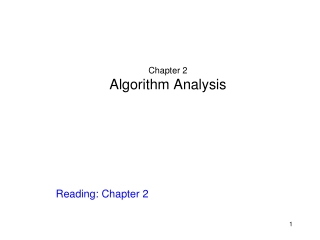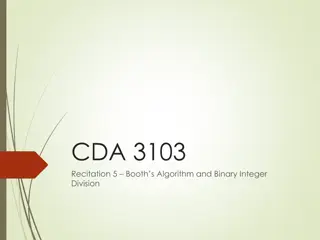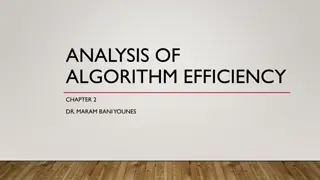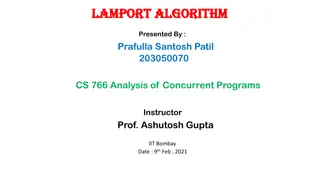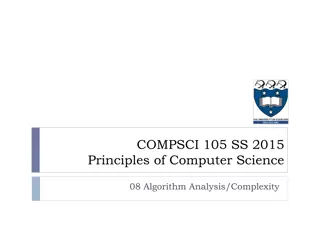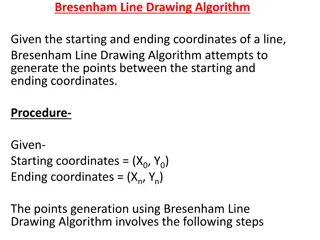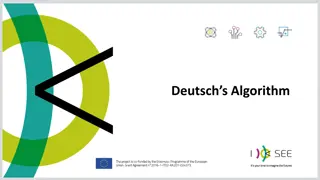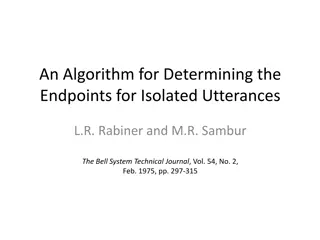Algorithm Design and Course Updates
In this content, you will find information on CSE 373 Algorithm Design, course evaluations, problem-solving approaches, and class updates. It includes details on solving well-known problems, brute force algorithms, linear problem-solving, and upcoming schedules. The content also emphasizes the importance of course evaluations and exam preparation strategies.
Uploaded on Feb 15, 2025 | 2 Views
Download Presentation

Please find below an Image/Link to download the presentation.
The content on the website is provided AS IS for your information and personal use only. It may not be sold, licensed, or shared on other websites without obtaining consent from the author.If you encounter any issues during the download, it is possible that the publisher has removed the file from their server.
You are allowed to download the files provided on this website for personal or commercial use, subject to the condition that they are used lawfully. All files are the property of their respective owners.
The content on the website is provided AS IS for your information and personal use only. It may not be sold, licensed, or shared on other websites without obtaining consent from the author.
E N D
Presentation Transcript
CSE 373 DECEMBER 4TH ALGORITHM DESIGN
ASSORTED MINUTIAE P3P3 scripts running right now Pushing back resubmission to Friday Next Monday office hours 12:00-2:00 last minute exam questions Topics list and old practice exams out after class Practice exam (hopefully tomorrow), by Wednesday night
ASSORTED MINUTIAE Course evaluations Very important to this class and this department Above all, they re very important to me Should only take ~5 minutes, and it s very valuable feedback 17 of you so far and I m going to bug you until it s above 75% Save yourself the 15 emails and just fill it out
ALGORITHM DESIGN Solving well known problems is great, but how can we use these lessons to approach new problems?
ALGORITHM DESIGN Solving well known problems is great, but how can we use these lessons to approach new problems? Guess and Check (Brute Force) Linear Solving Divide and Conquer Greedy-first Randomization and Approximation Dynamic Programming
BRUTE FORCE Classic na ve approach to algorithm design
BRUTE FORCE Classic na ve approach to algorithm design A Brute Force Algorithm revolves primarily around attempting all possible outcomes Bogo sort Travelling salesman Longest path
BRUTE FORCE If the problem is very difficult, then brute force may not be the worst solution Cracking RSA Low-reward problems Small, non-time-constrained
LINEAR SOLVING Basic linear approach to problem solving
LINEAR SOLVING Basic linear approach to problem solving If the decider creates a set of correct answers, find one at a time
LINEAR SOLVING Basic linear approach to problem solving If the decider creates a set of correct answers, find one at a time Selection sort: find the lowest element at each run through Sometimes, the best solution Find the smallest element of an unsorted array
LINEAR SOLVING Important to understand What piece of information brings you one step closer to the final answer?
LINEAR SOLVING Important to understand What piece of information brings you one step closer to the final answer? Exam problem simple solution Not always bad, O(n) problems lend themselves well to linear solving
DIVIDE AND CONQUER Divide-and-conquer algorithms divide the work and perform work seperately (usually recursively) Works best for O(nk) problems Why?
DIVIDE AND CONQUER Divide-and-conquer algorithms divide the work and perform work seperately (usually recursively) Works best for O(nk) problems (k>1) Why? If an algorithm is n2 work, and we divide into two halves, we ve halved the work!
DIVIDE AND CONQUER Divide-and-conquer algorithms divide the work and perform work seperately (usually recursively) Works best for O(nk) problems (k>1) Why? If an algorithm is n2 work, and we divide into two halves, we ve halved the work! Recurrences are going to play a big role in this
GREEDY-FIRST A Greedy-first algorithm is any algorithm that makes the move that seems best now These can be divide-and-conquer algorithms or linear algorithms Dijkstra s and Ford-Fulkerson are both Greedy-first algorithms Notice, however, Dijkstra s finds the correct answer easily, and Ford-Fulkerson requires some augmentation to guarantee correctness
ALGORITHM DESIGN Which approach should be used comes down to how difficult the problem is
ALGORITHM DESIGN Which approach should be used comes down to how difficult the problem is How do we describe problem difficulty? P : Set of problems that can be solved in polynomial time
ALGORITHM DESIGN Which approach should be used comes down to how difficult the problem is How do we describe problem difficulty? P : Set of problems that can be solved in polynomial time NP : Set of problems that can be verified in polynomial time
ALGORITHM DESIGN Which approach should be used comes down to how difficult the problem is How do we describe problem difficulty? P : Set of problems that can be solved in polynomial time NP : Set of problems that can be verified in polynomial time EXP: Set of problems that can be solved in exponential time
ALGORITHM DESIGN Some problems are provably difficult
ALGORITHM DESIGN Some problems are provably difficult Humans haven t beaten a computer in chess in years, but computers are still far away from solving chess
ALGORITHM DESIGN Some problems are provably difficult Humans haven t beaten a computer in chess in years, but computers are still far away from solving chess At each move, the computer needs to approximate the best move
ALGORITHM DESIGN Some problems are provably difficult Humans haven t beaten a computer in chess in years, but computers are still far away from solving chess At each move, the computer needs to approximate the best move Certainty always comes at a price
APPROXIMATION DESIGN What is approximated in the chess game?
APPROXIMATION DESIGN What is approximated in the chess game? Board quality If you could easily rank which board layout in order of quality, chess is simply choosing the best board
APPROXIMATION DESIGN What is approximated in the chess game? Board quality If you could easily rank which board layout in order of quality, chess is simply choosing the best board It is very difficult, branching factor for chess is ~35
APPROXIMATION DESIGN What is approximated in the chess game? Board quality If you could easily rank which board layout in order of quality, chess is simply choosing the best board It is very difficult, branching factor for chess is ~35 Look as many moves into the future as time allows to see which move yields the best outcome
APPROXIMATION DESIGN Recognize what piece of information is costly and useful for your algorithm
APPROXIMATION DESIGN Recognize what piece of information is costly and useful for your algorithm Consider if there is a cheap way to estimate that information
APPROXIMATION DESIGN Recognize what piece of information is costly and useful for your algorithm Consider if there is a cheap way to estimate that information Does your client have a tolerance for error? Can you map this problem to a similar problem? Greedy algorithms are often approximators
RANDOMIZATION DESIGN Randomization is also another approach
RANDOMIZATION DESIGN Randomization is also another approach Selecting a random pivot in quicksort gives us more certainty in the runtime
RANDOMIZATION DESIGN Randomization is also another approach Selecting a random pivot in quicksort gives us more certainty in the runtime This doesn t impact correctness, a randomized quicksort still returns a sorted list
RANDOMIZATION DESIGN Randomization is also another approach Selecting a random pivot in quicksort gives us more certainty in the runtime This doesn t impact correctness, a randomized quicksort still returns a sorted list Two types of randomized algorithms Las Vegas correct result in random time
RANDOMIZATION DESIGN Randomization is also another approach Selecting a random pivot in quicksort gives us more certainty in the runtime This doesn t impact correctness, a randomized quicksort still returns a sorted list Two types of randomized algorithms Las Vegas correct result in random time Montecarlo estimated result in deterministic time
RANDOMIZATION DESIGN Can we make a Montecarlo quicksort?
RANDOMIZATION DESIGN Can we make a Montecarlo quicksort? Runs O(n log n) time, but not guaranteed to be correct
RANDOMIZATION DESIGN Can we make a Montecarlo quicksort? Runs O(n log n) time, but not guaranteed to be correct Terminate a random quicksort early!
RANDOMIZATION DESIGN Can we make a Montecarlo quicksort? Runs O(n log n) time, but not guaranteed to be correct Terminate a random quicksort early! If you haven t gotten the problem in some constrained time, just return what you have.
RANDOMIZATION DESIGN How close is a sort? If we say a list is 90% sorted, what do we mean?
RANDOMIZATION DESIGN How close is a sort? If we say a list is 90% sorted, what do we mean? 90% of elements are smaller than the object to the right of it?
RANDOMIZATION DESIGN How close is a sort? If we say a list is 90% sorted, what do we mean? 90% of elements are smaller than the object to the right of it? The longest sorted subsequence is 90% of the length?
RANDOMIZATION DESIGN How close is a sort? If we say a list is 90% sorted, what do we mean? 90% of elements are smaller than the object to the right of it? The longest sorted subsequence is 90% of the length? Analysis for these problems can be very tricky, but it s an important approach
RANDOMIZATION Guess and check
RANDOMIZATION Guess and check How bad is it?
RANDOMIZATION Guess and check How bad is it? Necessary for some hard problems
RANDOMIZATION Guess and check How bad is it? Necessary for some hard problems Still can be useful for some easier problems
RANDOMIZATION Guess and check How bad is it? Necessary for some hard problems Still can be useful for some easier problems Hugely dependent on how good the checker is


